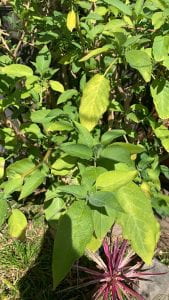March 31, 2020
Location: 37°13’16.3″N 121°52’20.4″W
Elevation: 82 ft
Driving Directions from USF:
Topography: flat
General habitat: chaparral
Signs of Spring:
1. The Camelia japonica (Japanese camellia) is blooming! Camelia japonica bloom in early Spring when grown outdoors. (in my backyard)
2. The Armeria maritima (sea thrift) is blooming! Armeria maritima is a dainty plant, native to central and southern Europe. Flowers blooms from late spring to early summer. (in my backyard)
3. The Callianthe picta (redvein abutilon) is blooming! Callianthe picta bloom throughout Spring. (in my front yard)
Leaf Descriptions:
1. Cordyline fruticosa (ti plant): This is a long-lived broadleaf evergreen that features thin lance shaped leaves, to 30 inches and 6 inches wide, that emerge pinkish red, but mature to deep green.
2. Brugmansia suaveolens (angels trumpet): a semi-woody shrub with a many-branched trunk. The leaves are light green and resemble ovals. They are 10 in long by 6 in wide.
3. Acer palmatum (Japanese maple): have small start shaped leaves, 1.5 – 3 inches wide, with five or seven lobes and double-serrate margins.
Narrative: I observed plants in my front and back yard. Upon making my observations it was 58º F outside, with no wind, with 71% humidity. I encountered many native and Japanese plant species around my home. I was curious as to how my backyard could sustain so many Japanese species given that they are not native to California. After doing some research on the Japanese maple, I found that the species has adapted to withstand drought, high soil salinity, and several types of soil including clay, loam, sand, slightly alkaline, acidic, and well-drained types.






